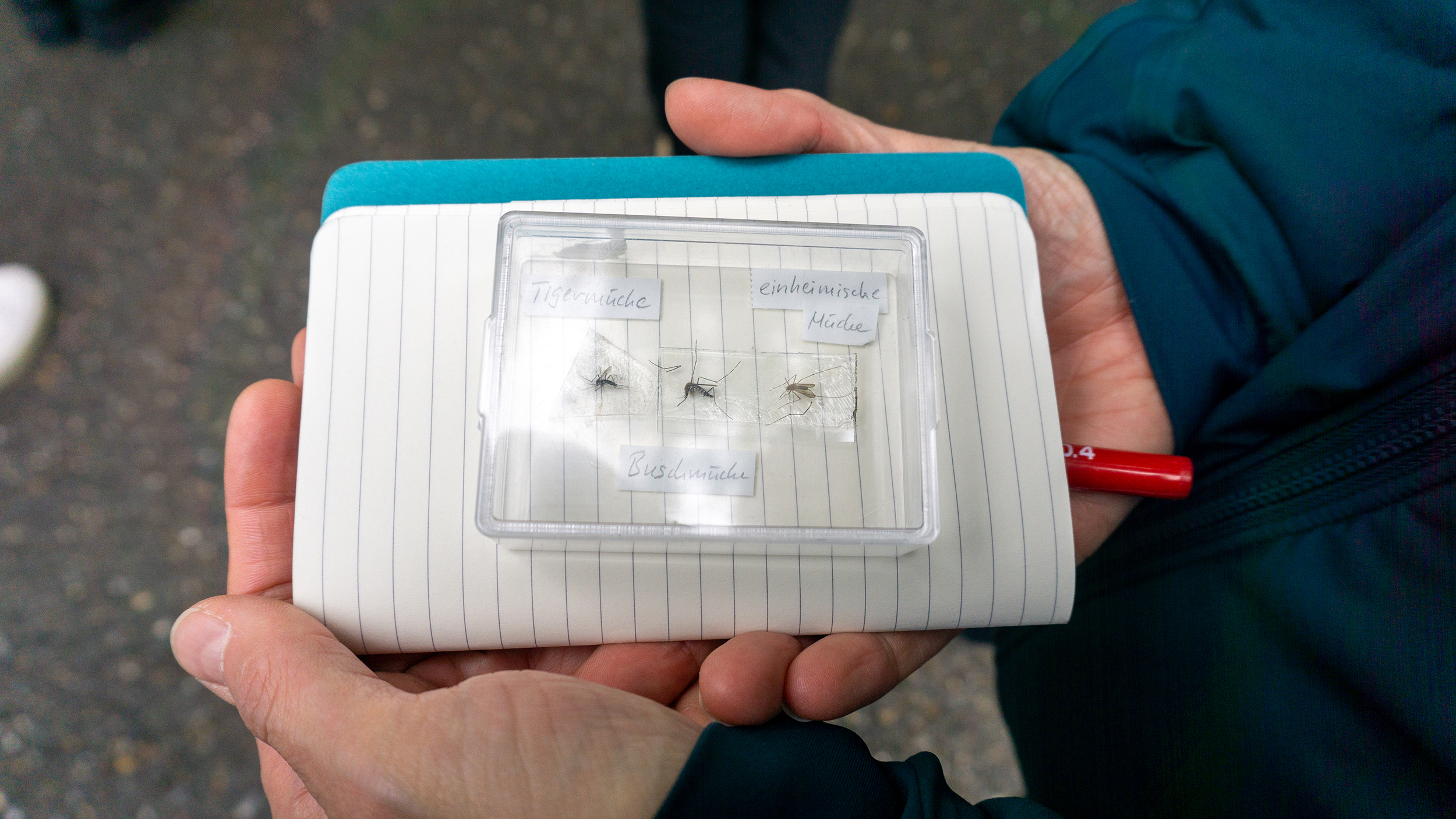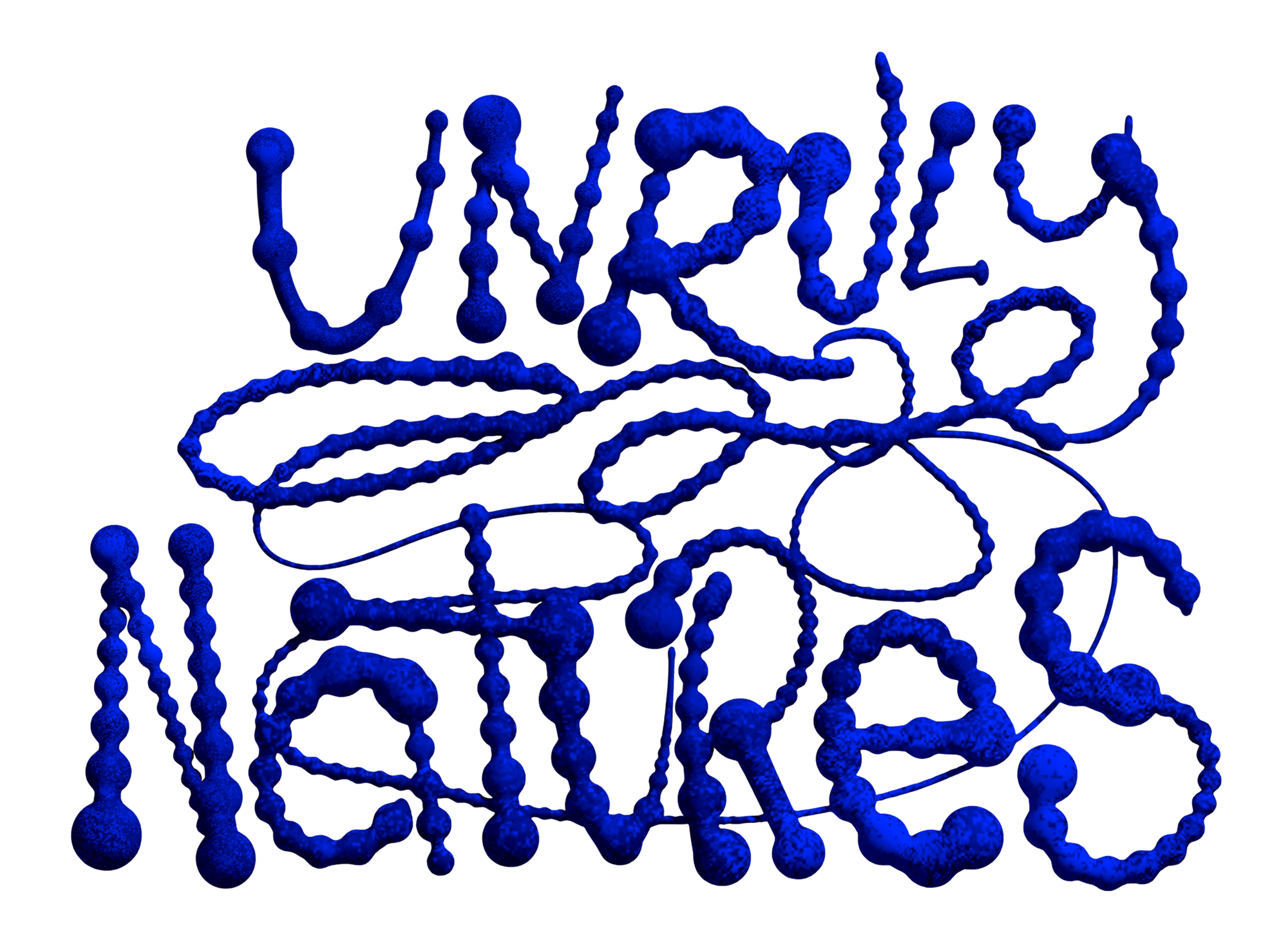︎
Field Notes September 25th 2022
Written by Nitin Bathla
Photographs by: Emiliano Guaraldo
(other authors see image credits)
Becoming a Tiger: Entangled Migrations, Surveillance, and Performing the Zoonosis of the Asian Tiger Mosquito
︎

It is rare that we as urbanists leave behind our anthropocentric urban sensoriums to think about how we cohabit our cities with non-human species, and even rarer that we experience the urban sensorium of species that we can barely see such as mosquitoes and insects.
The Cohabitation and Zoonosis at the Platzspitz tour, organised in collaboration with the Urban Pest Advisory Service of the city of Zurich as part of the Unruly Natures excursion attempted to immerse our group into one such urban sensorium in the city of Zurich. The sensorium of the Asian tiger mosquito (Aedes albopictus), is a specie that is categorised as an Invasive mosquito species (IMS) in Europe. Our interlocutor and tour guide describes Zurich as a frontier of the war against the Asian tiger mosquito (Aedes albopictus); “its population is already well established across much of Southern Europe, including the whole of Italy, parts of Greece, France, and the Mediterranean Coast of France, the mosquito has even established itself in the canton of Ticino in Southern Switzerland”, she adds.
The mosquito arrived in Europe from South and Southeast Asia through scrap tyres imported from South and Southeast Asia, she adds glancing at me (perhaps due to my clearly South Asian appearance). Once the exoticism of the Tiger mosquito was established, our tour guide proceeded to draw our attention to the terrifying zoonosis that it is capable of: “This mosquito is a vector of deadly tropical diseases such as the yellow fever virus, dengue fever, and Chikungunya fever. If the tiger mosquito bites a human infected with one of these diseases, it can transmit it to other healthy humans, triggering a local epidemic.”
Our gathering at the bus station suddenly assumed a sombre tone. It was as if all of a sudden there was an invisible enemy among us; an invisible enemy that, despite its minute size, was capable of large crimes of bioterror. Perhaps reminiscent of Dr. Kaplan, the main protagonist in Kenneth J. Stein's 2020 novel Tiger Mosquitoes: A Medical Crime Thriller. In the novel, Dr. Kaplan accidentally carries a mosquito-borne haemorrhagic fever back to the United States after being on a medical investigation in Uganda. In fact, animals have always been framed as epidemic villains, as Christos Lynteris aptly reminds us in his recently edited volume.1
“We have been trained to hate mosquitoes”, Maurits Bastiaan Meewijk proclaims in his brilliant piece in the same book. However, some mosquitoes have been vilified over others and whom we have learnt to identify and hate far more. Our tour guide draws our attention to the importance of being able to identify the Asian tiger mosquito over the deceptively similar-looking Bush Mosquito (Aedes japonicus japonicus) and “our native mosquito the Einheimische Mücke (probably Culex pipiens). This mosquito is extremely common in the cities of South and Southeast Asia. It has black and white stripes like a tiger”, she adds. Tigers have exclusively yellow and black stripes unless it is the rare white tiger, so why not call it the Zebra mosquito? Perhaps to add to its exotic Asianness, I think to myself.
 Figure 1. A picture of the striped Asian Tiger mosquito with a blood meal in its belly. Image credit: James Gathany, CDC
Figure 1. A picture of the striped Asian Tiger mosquito with a blood meal in its belly. Image credit: James Gathany, CDCOur tour guide passes around a box with the specimen of the three mosquitoes pasted next to each other along with a magnifying glass. She encourages us to recognise the subtle differences in stripes, patterns, and colours between the specimens under the power of the magnifying glass. Such magnifications are necessary because most countries rely on their citizens and citizen science for species surveillance in order to save money and resources.2
Such magnifications are not merely ocular however, they are often performed through personification; one needs to feel and understand in an intimate way how the anatomy of the non-human enables zoonosis. For instance, by now we are all too familiar with the anatomy of the SARS-CoV-2 virus and its microscopic spikiness that is personified through signs and symbols in everyday life. We soon witnessed the personification of the Tiger mosquito by our tour guide. She attempts to magnify the zoonosis of the Tiger mosquito.
Our tour guide tilted her posture in order to replicate how the tiger mosquito appears mid-flight. She then proceeded to describe to us how the Tiger mosquito follows passengers when they are about to board the bus in Italy. The mosquito then stays in the bus, constantly feeding on the passengers for bloodmeals and finally deboarding with them at the Zurich bus station after its long-distance journey. A cunning little insect, it seems, playing hide and seek with the law and the Swiss society. Next, our tour guide describes how the mosquito might bite an adult carrying tropical diseases like dengue, getting a blood meal, she adds, rubbing the lower part of her abdomen; one could almost hear a buzz behind her voice.
The mosquito then would go and bite another healthy adult transmitting pathogens and thus spreading the disease. We therefore have to trap and eradicate the mosquito here otherwise it would spread uncontrollably throughout Zurich. I ask what about the people traveling by car and the introductions at the bus layovers, to which our tour guide replies, yes, we lay the traps at the layovers as well, and yes, the mosquitoes travel with people by car as well.
She adds that the Tiger mosquito has been reported in Zürich Wollishofen and Hottingen, and that is why we require citizens to be aware of how it looks like and add to our surveillance of it. The fact that the Tiger mosquito can be introduced almost anywhere means that the city deploys yet another technique to keep the zoonosis of the tiger mosquito under check - whenever a tropical disease such as Dengue fever is reported, the city fumigates the entire vicinity around the reported site to eradicate any mosquitoes that might be there.
Such magnifications are not merely ocular however, they are often performed through personification; one needs to feel and understand in an intimate way how the anatomy of the non-human enables zoonosis. For instance, by now we are all too familiar with the anatomy of the SARS-CoV-2 virus and its microscopic spikiness that is personified through signs and symbols in everyday life. We soon witnessed the personification of the Tiger mosquito by our tour guide. She attempts to magnify the zoonosis of the Tiger mosquito.
The Tiger mosquito’s tiny size of less than a centimetre makes it barely visible to the casual viewer. Instead, it is often drawn to visibility only through the irksome buzz of its swarming or its tenacious bite, which is usually followed by people squatting their hands around in an attempt to catch the mosquito between their palms, instantly squatting it into a flat, lifeless profile.
Our tour guide tilted her posture in order to replicate how the tiger mosquito appears mid-flight. She then proceeded to describe to us how the Tiger mosquito follows passengers when they are about to board the bus in Italy. The mosquito then stays in the bus, constantly feeding on the passengers for bloodmeals and finally deboarding with them at the Zurich bus station after its long-distance journey. A cunning little insect, it seems, playing hide and seek with the law and the Swiss society. Next, our tour guide describes how the mosquito might bite an adult carrying tropical diseases like dengue, getting a blood meal, she adds, rubbing the lower part of her abdomen; one could almost hear a buzz behind her voice.
The mosquito then would go and bite another healthy adult transmitting pathogens and thus spreading the disease. We therefore have to trap and eradicate the mosquito here otherwise it would spread uncontrollably throughout Zurich. I ask what about the people traveling by car and the introductions at the bus layovers, to which our tour guide replies, yes, we lay the traps at the layovers as well, and yes, the mosquitoes travel with people by car as well.
She adds that the Tiger mosquito has been reported in Zürich Wollishofen and Hottingen, and that is why we require citizens to be aware of how it looks like and add to our surveillance of it. The fact that the Tiger mosquito can be introduced almost anywhere means that the city deploys yet another technique to keep the zoonosis of the tiger mosquito under check - whenever a tropical disease such as Dengue fever is reported, the city fumigates the entire vicinity around the reported site to eradicate any mosquitoes that might be there.
 Figure 2. Currently known distribution of Aedes albopictus by October 2014. Parts of Switzerland (the Canton of Ticino) consist established population of Aedes albopictus while most of Switzerland in yellow emerges as a frontier for Aedes albopictus. Source: ECDC-EFSA 2014/VECTORNET
Figure 2. Currently known distribution of Aedes albopictus by October 2014. Parts of Switzerland (the Canton of Ticino) consist established population of Aedes albopictus while most of Switzerland in yellow emerges as a frontier for Aedes albopictus. Source: ECDC-EFSA 2014/VECTORNETAs we, the Unruly Natures group, are still mulling over the containment infrastructure at the bus station, our tour guide demonstrates how she performs concealment and containment against the Aedes albopictus. She offers us to give a tour of how the traps work and where she conceals them. Contrary to our expectations, as devices, the traps referred to as Ovitraps are relatively simple. They comprise a simple bucket filled with water mixed with an insecticide that kills the mosquitoes in their larval stage, preventing its further metamorphosis into an adult.
The traps are concealed all over the thin strip of wooded landscape surrounding the bus station. The tiger mosquito loves the woods and is attracted to the water containers.
The last two years were really good for us, our tour guide claims, there were almost no sightings of the Tiger mosquito due to low human mobility and now things are intense once again, we have had nine sightings of the Tiger mosquito already this year. Next, our tour guide introduces us to another apparatus known as the Biogents Sentinel trap, which is designed to catch the adult female mosquito. She adds that these traps contain a bioagent that attracts host-seeking adult females, entrapping them and keeping us safe.
In the final act of the performance, our tour guide brings us to a possible breeding ground for the Tiger mosquito, an open manhole covered with stagnant water. The mosquito will lay eggs here that can hatch into adults, we, therefore, need to take preventive measures to contain it by killing the larvae through a bioagent. I question the need for the bioagent, bringing an example from my native India, where the Tiger mosquito is endemic. I ask, why not spray the surface with a thin coat of oil, which will deprive the larvae of air and perform containment without contamination? “Oh, that is too outdated, we used to do it here in Zurich back in the days. Let me show you how we do it nowadays”, replies our tour guide. She then brings out a long pipe from a bag she has been carrying all this while. She inserts one end of the pipe into an open manhole cover and puts a funnel at its other end, she then proceeds to drop a few tablets of the insecticide into the funnel, that are delivered into the stagnant water of the manhole at the other end with surgical precision. The insecticide is completely safe for humans, she proclaims, the parts per million are entirely safe. How these supposedly safe parts per million accumulate into the toxicity of urban waterbodies and urban soils is by now all too familiar and something which has been written about extensively by people such as Seth Denizen.
The traps are concealed all over the thin strip of wooded landscape surrounding the bus station. The tiger mosquito loves the woods and is attracted to the water containers.
A wooden ladle inserted in the bucket collects the mosquito eggs, which our tour guide then sends to a lab in Ticino for further examination. The lab determines the count of tiger mosquitoes in relation to the overall eggs in the batch.
The last two years were really good for us, our tour guide claims, there were almost no sightings of the Tiger mosquito due to low human mobility and now things are intense once again, we have had nine sightings of the Tiger mosquito already this year. Next, our tour guide introduces us to another apparatus known as the Biogents Sentinel trap, which is designed to catch the adult female mosquito. She adds that these traps contain a bioagent that attracts host-seeking adult females, entrapping them and keeping us safe.
In the final act of the performance, our tour guide brings us to a possible breeding ground for the Tiger mosquito, an open manhole covered with stagnant water. The mosquito will lay eggs here that can hatch into adults, we, therefore, need to take preventive measures to contain it by killing the larvae through a bioagent. I question the need for the bioagent, bringing an example from my native India, where the Tiger mosquito is endemic. I ask, why not spray the surface with a thin coat of oil, which will deprive the larvae of air and perform containment without contamination? “Oh, that is too outdated, we used to do it here in Zurich back in the days. Let me show you how we do it nowadays”, replies our tour guide. She then brings out a long pipe from a bag she has been carrying all this while. She inserts one end of the pipe into an open manhole cover and puts a funnel at its other end, she then proceeds to drop a few tablets of the insecticide into the funnel, that are delivered into the stagnant water of the manhole at the other end with surgical precision. The insecticide is completely safe for humans, she proclaims, the parts per million are entirely safe. How these supposedly safe parts per million accumulate into the toxicity of urban waterbodies and urban soils is by now all too familiar and something which has been written about extensively by people such as Seth Denizen.

The conclusion of the presentation to me opens more questions than it answers. There are holes and gaping absences in her enactment of the Tiger mosquito’s zoonosis. Firstly, I would argue, while is is true that the mosquito did arrive in Italy through the global trade of used tyres. It arrived to the peripheries of the cities of Padova and Bologna in the Veneto and Emilia Romagna region via tyres imported from Southern United States, not from South and Southeast Asia.
Containment infrastructure with traps similar to the ones at the Zurich bus station is often laid out in tank stations and bus layovers along highways, for example. Furthermore, it is not the mosquito in itself that is a problem, but the inequality in global access to healthcare. The fact that the endemicity of several viral diseases like dengue is managed instead of its systematic eradication by the World Health Organisation in certain peripheral parts of the world located in the so-called global south is what lies at the heart of the problem here.
The enactment of border and surveillance regimes on human and non-human mobility helps maintain these contradictions and site-specific extinction regimes. These surveillance and border regimes are often contiguous and intersectional with regimes that contain human mobility, in fact. Intersectional with the architecture of containment that surrounds the bus station – an invisible swarm of police also surrounds the bus station I could see police several incidences where the police conducted random checks on people of colour from the corner of my eye.
It would be interesting to see how such border regimes would continue to function under the effects of manmade climate change. For instance, it is estimated that the Tiger mosquito's habitat would shift further towards the poles with inincreased global temperatures alongside the climate change indued refugee crisis. There is an increasing realisation that with climate change, the existing architectures of containment and exclusion will become ineffective. This has resulted in the invention of even more nefarious regimes of biopolitical control, for instance, there have been attempts to bioengineer the tiger mosquito itself.
Trials have been conducted to genetically modify the Aedes aegypti mosquito, a close relative of the Aedes albopictus. Once genetically modified mosquitos mate with female mosquitoes in the wild, they result in sterile offspring. It is yet unknown what kind of knockoff effects such genetic modifications might unleash, however recently, the first such genetically modified have already been released in Florida Keys, United States4, with planned introductions in the Cayman Islands, Malaysia and Brazil, where these plans are being met with civil society protests.5
The story of the Tiger mosquito then is the story of the Capitolocene3, or in other words, how capitalism has remade and recast the planet in its image. Non-human species like the Tiger mosquito occupy ecological niches created by anthropogenic change. Although the city is often presented as the frontier of its ‘colonisation’, the infrastructure of its containment is often much more extensive.
Containment infrastructure with traps similar to the ones at the Zurich bus station is often laid out in tank stations and bus layovers along highways, for example. Furthermore, it is not the mosquito in itself that is a problem, but the inequality in global access to healthcare. The fact that the endemicity of several viral diseases like dengue is managed instead of its systematic eradication by the World Health Organisation in certain peripheral parts of the world located in the so-called global south is what lies at the heart of the problem here.
The enactment of border and surveillance regimes on human and non-human mobility helps maintain these contradictions and site-specific extinction regimes. These surveillance and border regimes are often contiguous and intersectional with regimes that contain human mobility, in fact. Intersectional with the architecture of containment that surrounds the bus station – an invisible swarm of police also surrounds the bus station I could see police several incidences where the police conducted random checks on people of colour from the corner of my eye.
It is at sites such as the bus station where the contradictions of capitalism and its ecology in the web of life are reconciled under the production of narratives of criminality, exclusion, and pathology.
It would be interesting to see how such border regimes would continue to function under the effects of manmade climate change. For instance, it is estimated that the Tiger mosquito's habitat would shift further towards the poles with inincreased global temperatures alongside the climate change indued refugee crisis. There is an increasing realisation that with climate change, the existing architectures of containment and exclusion will become ineffective. This has resulted in the invention of even more nefarious regimes of biopolitical control, for instance, there have been attempts to bioengineer the tiger mosquito itself.
Trials have been conducted to genetically modify the Aedes aegypti mosquito, a close relative of the Aedes albopictus. Once genetically modified mosquitos mate with female mosquitoes in the wild, they result in sterile offspring. It is yet unknown what kind of knockoff effects such genetic modifications might unleash, however recently, the first such genetically modified have already been released in Florida Keys, United States4, with planned introductions in the Cayman Islands, Malaysia and Brazil, where these plans are being met with civil society protests.5
 Figure 3. CEM Taquaralto students during mobilization on Tocantins Avenue - Photo: Adilvan Nogueira/Governo do Tocantins
Figure 3. CEM Taquaralto students during mobilization on Tocantins Avenue - Photo: Adilvan Nogueira/Governo do TocantinsPortuguese artist Pedro Neves Marques plays on the transformation of the mosquito into a ‘post-natural insect’. His 2017 animated video installation Aedes aegypti animates the mosquito into a virtual atmosphere, where it appears surrounded by a toxic cloud of chemicals, sucking blood from the human skin while engaging in a dance of copulation.
These rituals would attempt to magnify the tiny Aedes albopictus. At the end of rains for example, one would often see municipal officials carrying fumigation devices at the back of their bicycles, spraying insecticides, with kids singing and dancing in the clouds of toxic smoke, making the scene appear like a dance stage at an elaborate rave party.6
Officials and citizens would check puddles of water from door-to-door building a shared sense of care and respect. Perhaps in the future we will have to learn to live with the Tiger mosquito as we have lived with it for decades now in my native India. Public performances that attempt to magnify the zoonosis of non-human species such as the Tiger mosquito would benefit immensely from new narratives that emerge through the plugging of gaps and absences. Instead of deploying surveillance to uphold borders and keeping out the other using violent and destructive means, the new narratives could promote a new syncretic space that is yet to come.
As someone who grew up in India, I too, witnessed a regular performance of mosquito containment. This postcolonial performance, instead of being concealed as in the case of Switzerland, was all too public and pervasive. It was a part of everyday life and of yearly seasonal rhythms where every monsoon season would trigger an annual ritual of public hygiene, public action, and television adverts.
These rituals would attempt to magnify the tiny Aedes albopictus. At the end of rains for example, one would often see municipal officials carrying fumigation devices at the back of their bicycles, spraying insecticides, with kids singing and dancing in the clouds of toxic smoke, making the scene appear like a dance stage at an elaborate rave party.6
Officials and citizens would check puddles of water from door-to-door building a shared sense of care and respect. Perhaps in the future we will have to learn to live with the Tiger mosquito as we have lived with it for decades now in my native India. Public performances that attempt to magnify the zoonosis of non-human species such as the Tiger mosquito would benefit immensely from new narratives that emerge through the plugging of gaps and absences. Instead of deploying surveillance to uphold borders and keeping out the other using violent and destructive means, the new narratives could promote a new syncretic space that is yet to come.
Footnotes
1 Meerwijk, “Tiger Mosquitoes from Ross to Gates.”
2 Suter, “The Asian Tiger Mosquito Aedes Albopictus in Switzerland: Biology Surveillance and Control.”
3 Moore, “Capitalism in the Web of Life: Ecology and the Accumulation of Capital.”
4 Waltz, “First Genetically Modified Mosquitoes Released in the United States.”
5 Sudweeks, “Should We Let Them Go: A Narrative Policy Framework Analysis of the Policy Narratives Surrounding the Release of Genetically Modified Mosquitos in Brazil and the Florida Keys.”
6 A picture of fogging machine deployed by civic bodies in Delhi. Image Credit: Sonu Mehta/ HT Photo
![]()
1 Meerwijk, “Tiger Mosquitoes from Ross to Gates.”
2 Suter, “The Asian Tiger Mosquito Aedes Albopictus in Switzerland: Biology Surveillance and Control.”
3 Moore, “Capitalism in the Web of Life: Ecology and the Accumulation of Capital.”
4 Waltz, “First Genetically Modified Mosquitoes Released in the United States.”
5 Sudweeks, “Should We Let Them Go: A Narrative Policy Framework Analysis of the Policy Narratives Surrounding the Release of Genetically Modified Mosquitos in Brazil and the Florida Keys.”
6 A picture of fogging machine deployed by civic bodies in Delhi. Image Credit: Sonu Mehta/ HT Photo

